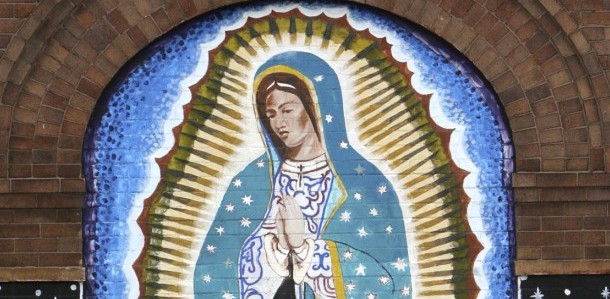Tepeyac, Mexico, 9 December 1531. A young woman appears to an indigenous peasant named Juan Diego. The woman, initially identified by Juan Diego as a teenaged Aztec princess, asks Juan Diego in his native language to have a shrine built in her name– she introduces herself as the Blessed Virgin Mary– on the site where he is standing. Juan Diego is sent to ask the permission of the bishop to build the shrine. The bishop, the Spaniard Juan de Zumárraga, is sceptical that Juan Diego had actually seen the Mother of God, so Juan Diego returns to Tepeyac. There, Our Lady appears to him again, this time promising him a sign that will convince Bishop de Zumárraga to do as she has requested.
The next day, on his way to visit his dying uncle, Juan Diego encounters the Virgin a third time. She assures him that his uncle will live, and tells him to go to Tepeyac in mid-winter and to gather Castilian roses– flowers native to the bishop’s homeland– and to bring them to Bishop de Zumárraga. Standing in front of the bishop to request again the construction of a shrine on Tepeyac, Juan Diego lets the Castilian roses fall from his cloak, on which an image of Mary has become imprinted. Later, he finds his uncle in good health. Bishop de Zumárraga is convinced by this “Sign of the Roses” that a shrine to Our Lady must be built. The Virgin who had appeared to Juan Diego had identified herself as Our Lady of Guadalupe. Devotion to Our Lady under this name begins to spread rapidly in the Americas and remains to the present the most popular Marian title in Latin America.
Millions of Aztecs were converted to Christianity within a few years of those events on December 12, 1531. Today, nearly five-hundred years later, that image can still be seen on Juan’s
tilma in the Basilica of Our Lady of Guadalupe. No scientific explanations have been found for the original image, the physical integrity of the
tilma itself (which should have naturally decomposed many centuries ago), or the flowers which Juan brought to the bishop.
On July 31, 2002, Pope John Paul II visited the Basilica of Our Lady of Guadalupe and proclaimed Juan Diego a saint – the first indigenous saint of the Americas. Quoting the Mexican bishops, JPII stated that, “The Guadalupe Event meant the beginning of evangelization with a vitality that surpassed all expectations. Christ’s message, through his Mother, took up the central elements of the indigenous culture, purified them and gave them the definitive sense of salvation.” (Homily of John Paul II, Mexico City, July 31, 2002) The power and depth of that event, encountered in the image of Our Lady, continues to inspire millions of devotions and pilgrimages each year.
---
photo courtesy of Catholic News Service
With files from Warren Schmidt, CSB, courtesy of Madrid11.com
